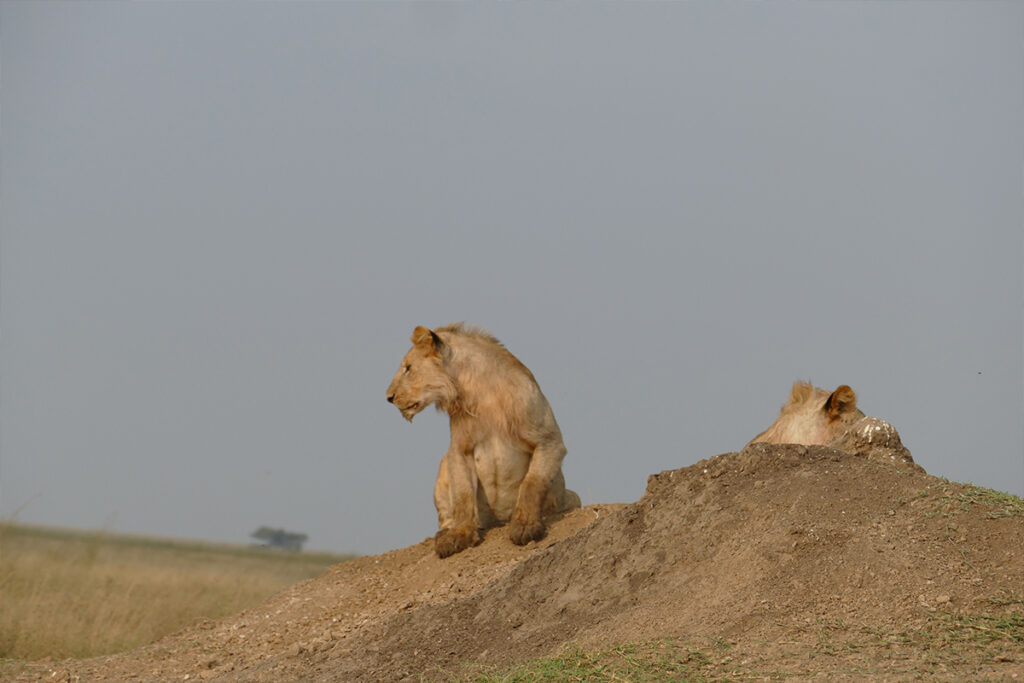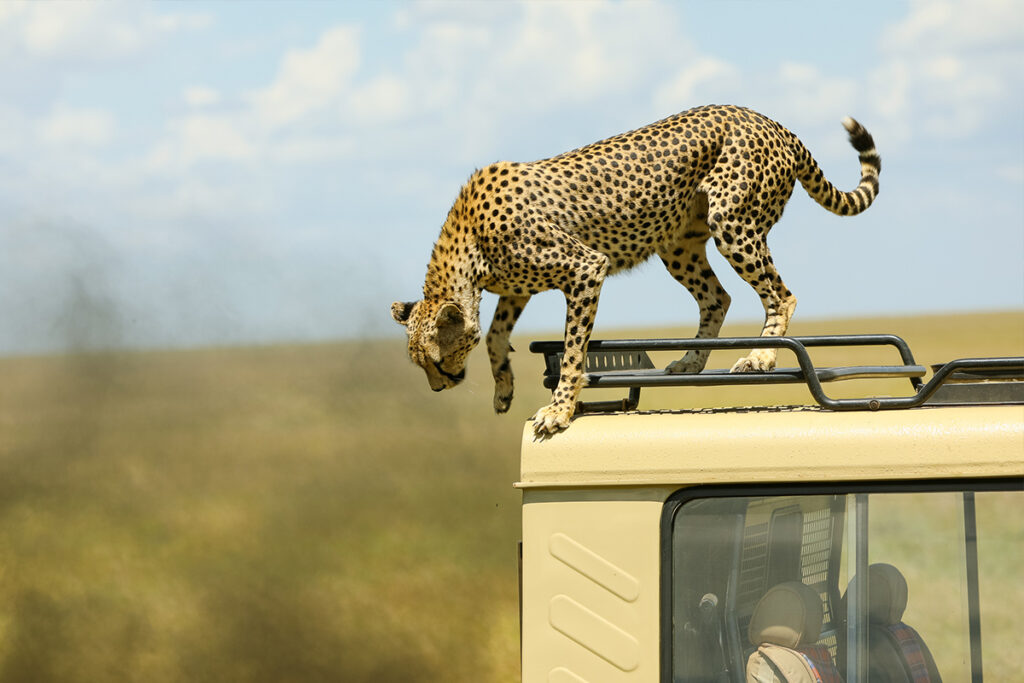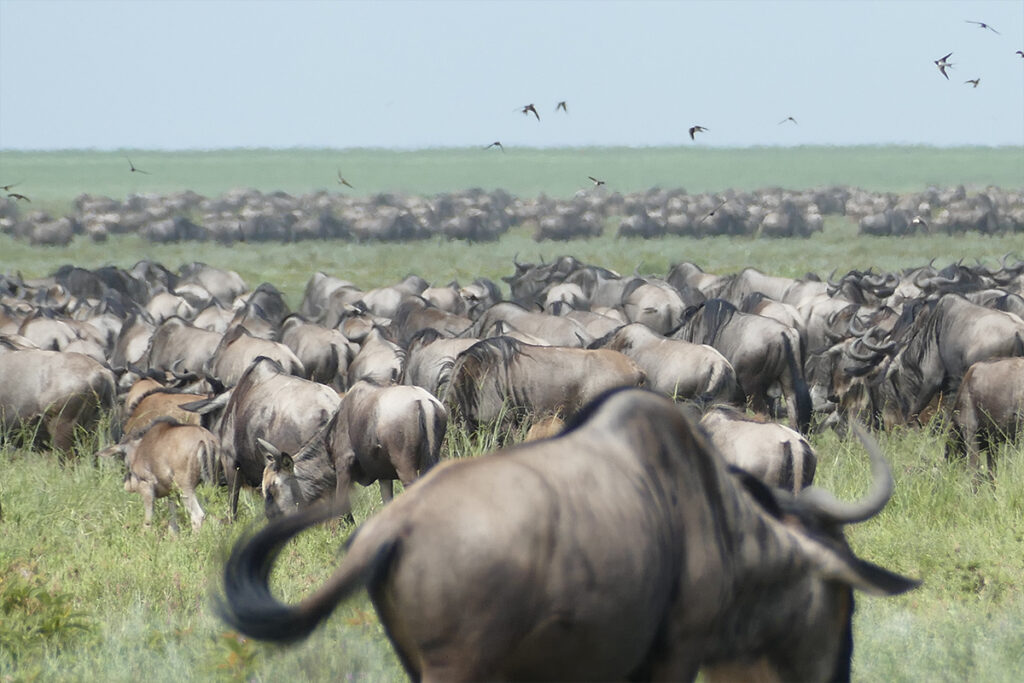In Tanzania, the wildebeest migration is so vast that it’s visible from space, an awe-inspiring testament to the abundance of life thriving in its national parks. This phenomenal display of nature’s grandeur captivates even seasoned conservationists and wildlife enthusiasts. Such raw, unfiltered biodiversity is a cornerstone of Tanzania’s international allure as it draws experts from around the globe eager to witness this unparalleled spectacle.
Tanzania’s wildlife safari roots trace back over a century when expeditions were first navigated through its savannahs and plains. Today, those verdant landscapes are home to over 4 million wild animals, a staggering number underscoring the country’s successful conservation efforts. The safari, an iconic symbol of African wildlife exploration, continues to flourish here, offering a unique blend of traditional heritage intertwined with modern sustainability practices.

Tanzania Wildlife Safari
Embarking on a Tanzania wildlife safari feels like stepping into a living documentary. Home to the Great Wildebeest Migration, Tanzania’s plains become a canvas of movement as over two million animals journey through its territories. This spectacle attracts travelers hoping to witness one of nature’s biggest events. The Serengeti National Park and Ngorongoro Crater are top spots to see this migration. For those interested in the latest trends, here is the post about safari adventures evolving in 2025.
Besides the big mammals, Tanzania is a birdwatcher’s paradise. With over 1,100 bird species recorded, every corner of the safari offers a new avian surprise. The vivid colors of the lilac-breasted roller and the striking beak of the African spoonbill are just some highlights. Guided tours help visitors spot and learn about these birds. Such diversity enriches the safari experience, making each trip unique.
Visiting Tanzania means diving into its cultural fabric as well. Many safaris include opportunities to interact with local tribes, such as the Maasai. These experiences offer insight into traditional ways of life and their harmonious coexistence with nature. Observing these communities, visitors often gain a deeper appreciation for sustainable living practices. According to the article, this blend of culture and wildlife forms a complete safari adventure.
A Tanzania safari wouldn’t be complete without a taste of its aromatic coffee. Tanzania’s coffee farms play a crucial role in its economy. Tours allow guests to see the journey of the coffee bean, from farm to cup. Visitors learn about cultivation, harvesting, and roasting processes. If intrigued about this aspect, here is the article that delves into the world of Tanzanian coffee.
Overview of Tanzania’s Rich Biodiversity and Conservation Efforts
Tanzania is a sanctuary for an incredible range of wildlife. From the vast herds of elephants in Tarangire National Park to the stealthy leopards in Ruaha National Park, the variety of animals is immense. This impressive diversity of species makes Tanzania a top destination for wildlife enthusiasts. The country’s protected parks and reserves play a crucial role in maintaining these populations. Equally, conservation efforts have been instrumental in preserving these ecosystems.
Efforts to protect Tanzania’s wildlife include anti-poaching programs and community engagement. Park rangers, specially trained to guard against illegal hunting, work tirelessly throughout the year. In addition, local communities are encouraged to participate in conservation activities. These initiatives create awareness and promote sustainable use of resources. The teamwork between conservationists and locals is vital for long-term success.
A glimpse into Tanzania’s flora adds another layer to its biodiversity story. The landscapes are dotted with iconic baobab trees and indigenous acacias, each offering refuge for countless creatures. Indigenous plants, like the sausage tree, not only add charm but support various animal species. Furthermore, numerous medicinal plants can be found, showcasing nature’s pharmacy. This blend of flora and fauna creates an interdependent environment.
Tanzania’s commitment to conservation has led to several milestones. In recent years, the black rhino population has slowly increased inside protected areas. Additionally, reforestation projects help combat desertification and restore habitats. Wildlife corridors that connect parks ensure genetic diversity among animal populations. As these efforts continue, Tanzania remains a global leader in wildlife conservation. The balance between human activity and nature is a delicate yet essential task.
Top National Parks to Visit on a Tanzania Safari
The Serengeti National Park is famous for the Great Wildebeest Migration. Each year, millions of animals traverse its grasslands. This park is a haven for photographers and tourists alike. Visitors often encounter lions, cheetahs, and elephants during their adventures. Serengeti offers a quintessential safari experience that captivates all who enter.
Ngorongoro Crater, another must-see destination, is a natural wonder. It houses a dense population of wildlife within its breathtaking caldera. Spotting the Big Five is easier here due to the enclosed environment. The lush, fertile terrain supports diverse animal life. Visitors can enjoy game drives and guided walks in this unique landscape.
In Tarangire National Park, the majestic baobab trees stand out against the savannah. It’s renowned for its large elephant herds, especially during the dry season. Wildlife enthusiasts can glimpse oryx, giraffes, and numerous bird species. The park’s swamps and rivers provide year-round watering holes for animals. These features make it a hidden gem among Tanzania’s parks.
For a more secluded experience, head to Ruaha National Park. It’s Tanzania’s largest park and a haven for predators like lions and leopards. Fewer tourists venture to Ruaha, offering a sense of solitude and exclusivity. Visitors can witness diverse landscapes, from rocky hills to sprawling plains. This commitment to preserving raw nature makes it a top choice for seasoned safari-goers.
Witnessing the Great Wildebeest Migration
Watching the Great Wildebeest Migration is a once-in-a-lifetime experience. Every year, over two million animals, including wildebeests, zebras, and gazelles, move across the Serengeti and Maasai Mara. This dramatic event occurs in search of greener pastures. The migration begins in Tanzania’s Serengeti National Park. The animals journey northward, following the rains.
This massive movement creates an incredible spectacle. Predators like lions and crocodiles follow closely behind, looking for food. As herds cross the Mara River, dramatic scenes of survival unfold. The river crossings are particularly thrilling to watch as animals brave the currents. Many visitors flock to see these heart-pounding moments during the migration season.
The best time for witnessing the migration in Tanzania is between June and October. During these months, animals gather in large numbers, creating breathtaking views. The Serengeti plains are alive with the sounds of thundering hooves. Visitors often prefer guided tours to take them to the best vantage points. Expert guides provide insights and ensure a safe viewing experience.
Accommodations along the migration route vary greatly. Options range from luxury lodges to basic campsites. Staying in mobile camps allows tourists to stay close to the action. These camps move with the migration, offering prime viewing locations. Each option provides a unique way to experience the vastness of the Serengeti.
Aside from wildlife, the scenic landscapes are stunning. Vast savannahs stretch on for miles under a bright blue sky. Sunrise and sunset create colorful backdrops for the journeying herds. Photographers seize these moments to capture lasting memories. The awe-inspiring beauty of nature is on full display.
Experiencing the Great Wildebeest Migration connects people with the raw power of nature. It highlights the importance of conservation efforts. Preserving these habitats ensures future generations will witness this natural wonder. Engaging in sustainable tourism helps protect these vital ecosystems. The migration reminds visitors of nature’s balance and beauty.
Unique Wildlife Experiences in Tanzania
Tanzania offers opportunities to witness rare wildlife up close. Night safaris in parks like Ruaha provide views of nocturnal animals. Imagine watching a leopard hunt under the moonlight. These thrilling adventures reveal a different side of nature. The sounds and sights of the night create unforgettable memories.
Bird watching is also exceptional in Tanzania. With more than 1,100 bird species, it’s a paradise for enthusiasts. Colors of birds like the lilac-breasted roller and the Fischer’s lovebird enchant visitors. Different habitats support various bird populations. Guided tours help spot rare and native species.
Chimpanzee trekking is a special experience in Gombe Stream and Mahale Mountains National Parks. Trekking through lush forests to see these primates is both exciting and educational. Visitors learn about chimpanzee behavior and conservation efforts. Close encounters with these intelligent animals are unforgettable. These treks are physical but rewarding ventures.
Consider snorkeling or diving in Tanzania’s coastal waters. Marine parks like Mafia Island offer vibrant coral reefs teeming with life. It’s common to see whale sharks and colorful fish while exploring underwater. These marine adventures complement the terrestrial safaris. The diversity of Tanzania’s wildlife extends from land to sea.
Tanzania also offers hot air balloon safaris. Floating above the Serengeti provides a bird’s-eye view of the landscapes and animals below. It’s a peaceful yet exhilarating way to observe the plains. The early morning light paints the savannah in beautiful colors. This experience is perfect for photography and serene observation.
Engaging with conservation projects directly enriches wildlife experiences. Visitors can join initiatives to track and protect endangered species. Such involvement creates a deeper connection to the land and its inhabitants. Supporting these efforts ensures the preservation of Tanzania’s natural wonders. These unique encounters contribute to meaningful and impactful travel.
Sustainable Tourism Practices in Tanzanian Safaris
Sustainable tourism in Tanzania focuses on reducing environmental impact while benefiting local communities. Eco-friendly lodges utilize solar power and rainwater harvesting systems. These practices help conserve resources and reduce carbon footprints. Many lodges also use biodegradable products and limit single-use plastics. This commitment ensures minimal disruption to natural habitats.
Involving local communities in tourism strengthens conservation efforts. Employing locals in safari operations and hospitality brings economic benefits to the community. This approach encourages environmental stewardship among residents. Visitors get insights into indigenous cultures, providing a more immersive experience. This collaboration boosts both conservation and cultural appreciation.
Conservation fees charged to tourists support protection initiatives. These funds aid anti-poaching programs and habitat restoration projects. Tourists play a vital role by contributing through these fees. The money collected goes back into preserving wildlife and landscapes. This system supports long-term conservation goals.
Guided tours emphasize responsible safari practices. Tour operators educate tourists on ethical wildlife viewing and respecting animal spaces. Maintaining safe distances and reducing noise are crucial aspects. Compliance with park regulations ensures minimal disturbance to wildlife. Educating visitors fosters a respectful approach to exploring nature.
Reforestation projects further illustrate Tanzania’s sustainable efforts. Replanting trees combats soil erosion and restores critical habitats. This effort helps maintain biodiversity and supports wildlife habitats. Visitors often participate in tree planting activities, enhancing their connection to conservation. Engaging tourists in such projects empowers them to contribute positively.
Tanzania’s integrated approach to sustainable tourism balances needs of nature and economy. Tourists are encouraged to choose eco-friendly options and consciously minimize waste. The goal is to protect Tanzania’s rich biodiversity for future generations. This model of conservation ensures wildlife thrives alongside human progress. Embracing eco-tourism contributes to a brighter future for Tanzania’s natural treasures.

Frequently Asked Questions
Discover insights on stunning safaris and diverse wildlife experiences across Tanzania’s vast landscapes. Let these answers guide you through your African adventure, offering practical information and thoughtful exploration tips.
1. What animals can you see on a Tanzanian safari?
On a Tanzanian safari, you’ll encounter the famous Big Five: lions, elephants, buffaloes, leopards, and rhinos. These iconic animals roam Tanzania’s national parks and reserves, providing unforgettable sightings for visitors. Alongside the Big Five, you can also spot cheetahs, zebras, giraffes, and numerous antelope species.
Birdwatchers will also rejoice at the sight of colorful marabou storks and lilac-breasted rollers. The country’s rich biodiversity offers a thrilling, well-rounded wildlife experience. With expert guides, you’ll learn fascinating facts about these creatures, making your safari truly educational and memorable.
2. When is the best time to visit Tanzania for a safari?
The best time for a safari in Tanzania depends on what you wish to see. The dry season, from June to October, is ideal for watching wildlife gather around water sources, offering excellent viewing conditions. This period is also perfect for witnessing the Great Wildebeest Migration across the Serengeti.
The wet season, from November to May, ushers in lush landscapes and newborn animals. Although some roads may be challenging to navigate, this season provides opportunities for birdwatching and witnessing calving events. Each season presents unique advantages to planning your Tanzanian adventure.
3. How should one prepare for a safari in Tanzania?
Proper preparation ensures a seamless and enjoyable safari experience. Pack lightweight, breathable clothing in neutral colors to blend with surroundings and deter insects. Don’t forget sturdy shoes for walks and game drives. Essential items include binoculars for wildlife watching, a sunhat, sunscreen, and insect repellent.
Consult with your travel doctor about vaccinations and preventive medications, such as malaria tablets. It’s also wise to have travel insurance coverage for your trip. With these preparations, you’ll be ready to explore Tanzania’s natural wonders with peace of mind.
4. Can sustainable tourism practices enhance a safari experience?
Sustainable tourism greatly enhances your safari in Tanzania, ensuring minimal impact on the environment. Choosing eco-friendly lodges and tours helps preserve Tanzania’s natural beauty and supports local communities. These accommodations often use renewable energy, source local ingredients, and generate less waste.
Join conservation activities like tree planting or anti-poaching initiatives to support wildlife protection. Engaging in these efforts provides a deeper connection with the land and people. It strengthens your experience and contributes to safeguarding Tanzania’s rich biodiversity.
5. Are Tanzanian safaris suitable for families with children?
Tanzanian safaris can offer enriching experiences for families, making them perfect for kids. Many lodges provide child-friendly activities and knowledgeable guides who excel at engaging young adventurers. Game drives and nature walks introduce children to wildlife, sparking curiosity and learning.
To ensure family safety, choose tours with certified guides and kid-friendly itineraries. Consider destinations with shorter travel distances and family-focused accommodations to enhance comfort. By planning accordingly, your family’s Tanzanian safari will be a fun and educational adventure for all ages.



